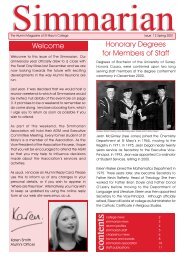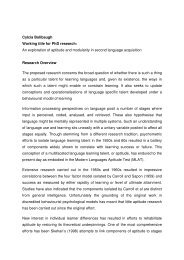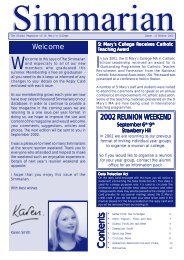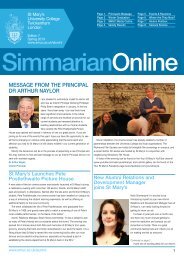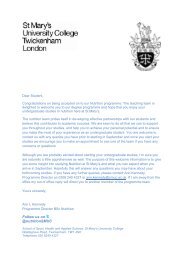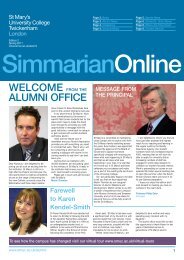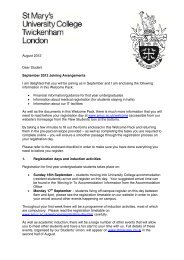Sociolinguistic, extralinguistic and cognitive factors underlying L1 ...
Sociolinguistic, extralinguistic and cognitive factors underlying L1 ...
Sociolinguistic, extralinguistic and cognitive factors underlying L1 ...
Create successful ePaper yourself
Turn your PDF publications into a flip-book with our unique Google optimized e-Paper software.
Agnieszka Kotula<br />
Working title: <strong>Sociolinguistic</strong>, <strong>extralinguistic</strong> <strong>and</strong> <strong>cognitive</strong> <strong>factors</strong> <strong>underlying</strong> <strong>L1</strong><br />
retention/proficiency among <strong>L1</strong> Polish attriters<br />
Research rationale:<br />
An ample body of research to date has been devoted to the various issues of second<br />
language acquisition (SLA). The research scope is too great to quote it here fully, but<br />
puzzles such as the <strong>L1</strong> (first language) influence on the acquisition of the second<br />
language (L2), the effects of various forms of L2 instruction, an array of L2<br />
acquisition settings, the role of sociological, biological <strong>and</strong> linguistic <strong>factors</strong>, as well<br />
as the effects of maturation processes have been, <strong>and</strong> are still being, explored by a<br />
galore of researchers. Within the last few decades an ample number of research<br />
projects have also been undertaken to investigate a sister subject, namely language<br />
attrition. The term ‘refers to a gradual decline in native language proficiency among<br />
migrants. As a speaker uses his/her L2 frequently <strong>and</strong> becomes proficient in it, some<br />
aspects of the <strong>L1</strong> can become subject to L2 influence or deteriorate due to the<br />
absence of confirming evidence in the input (Schmid 2009: 216).<br />
Various aspects of the phenomenon have been looked at from a number of angles.<br />
Some research focused primarily on the observable outcomes of <strong>L1</strong> attrition, such as<br />
changes or losses in various language components, such as accent retention (Major<br />
2010), syntax or lexis (Bar-Shalom <strong>and</strong> Zaretsky 2008) or fluency (Schmid <strong>and</strong><br />
Fägersten 2010). Other research studies concentrated around the <strong>underlying</strong> <strong>factors</strong><br />
having influence on the extent of attrition taking place. Among these, various<br />
research projects looked at the relationship between L2 acquisition <strong>and</strong> <strong>L1</strong> attrition<br />
(Optiz 2010), (Sharwood <strong>and</strong> Van Buren (1991), (Montrul 2005), (Pavlenko 2004),<br />
extra linguistic <strong>and</strong> sociolinguistic <strong>factors</strong> contributing to <strong>L1</strong> attrition, such as<br />
language affiliation, biological age, sex or education (Schmid <strong>and</strong> Dusseldorp 2010),<br />
(Kim 2008), <strong>and</strong> last but not least, the role of language aptitude <strong>and</strong> <strong>cognitive</strong><br />
maturation processes (Bylund, Abrahamsson <strong>and</strong> Hyltenstam 2009).
As <strong>L1</strong> attrition is a fully documented phenomenon, the purpose of this research will<br />
not be, for obvious reasons, to prove its existence or the depth <strong>and</strong> breadth per se.<br />
What will be the interest of this study is the latter, the <strong>underlying</strong> <strong>factors</strong> leading to<br />
attrition <strong>and</strong> more precisely, the <strong>factors</strong> that explain the lack of or a lesser degree of<br />
attrition processes among the <strong>L1</strong> attriters. Among these, the research will look at the<br />
possible <strong>factors</strong> contributing to these, such as, to start with, sociological setting of <strong>L1</strong><br />
attriters, i.e. the depth <strong>and</strong> breadth on <strong>L1</strong> input, the length of <strong>L1</strong> input, the length of<br />
residence in an L2 community, the level of education in general <strong>and</strong> the amount of<br />
education received in <strong>L1</strong>, the amount of interaction done though <strong>L1</strong> <strong>and</strong> other non<strong>cognitive</strong><br />
<strong>factors</strong> such as marital or family set up, belonging to any <strong>L1</strong> orientated<br />
organised bodies (clubs, churches or schools), etc.<br />
The other part of research will look at <strong>cognitive</strong> <strong>factors</strong> that might influence the extent<br />
of <strong>L1</strong> attrition, such as language aptitude <strong>and</strong> age effects.<br />
In the field of SLA the last two phenomena, separately or combined, have received a<br />
great deal of attention over the years <strong>and</strong> a number of most recent research papers<br />
have proven their significance in various settings <strong>and</strong> to various extents. The impact<br />
of the age of first exposure to L2 <strong>and</strong> language aptitude on the ultimate language<br />
attainment have been documented in such research papers as Johnson <strong>and</strong><br />
Newport (1989), DeKeyser (2000) or Abrahamson <strong>and</strong> Hyltemstam (2008). All<br />
conclude that there is a significant correlation between the early exposure to L2 <strong>and</strong><br />
the ultimate language proficiency. Broadly speaking, puberty is seen as a sensitive<br />
point that marks off the clear boundary for a predicted success at mastering L2,<br />
commonly referred to as Critical Period (CP). Critical Period Hypothesis (CPH)<br />
suggests that L2 learners exposed to the language at a later stage in their lives<br />
seem to not achieve as well in their ultimate L2 attainment as the ones with an early,<br />
pre-pubescent language exposure onset. DeKeyser (2000) goes to explain that the<br />
instances of L2 learners who begin acquiring L2 past puberty (CP) <strong>and</strong> still achieve<br />
native-like results in a Grammatically Judgemet Test (GJT) can be explained by their<br />
high language aptitude. Abrahamson <strong>and</strong> Hyltenstam’s (2008) study reveals that<br />
high language aptitude among late L2 starters is a contributing factor in their passing<br />
as a native speaker in everyday communication (but not, however, a sufficient<br />
condition for attaining the actual native-ness).
As previously implied, L2 acquisition <strong>and</strong> <strong>L1</strong> attrition might be conditioned by similar<br />
<strong>factors</strong>. Hence, <strong>L1</strong> attrition study has concentrated around the issues explored,<br />
previously or simultaneously, in SLA. Bylund (2009) suggests that the above<br />
mentioned maturation processes (CPH) so evident in SLA need to be looked at while<br />
studying the <strong>L1</strong> attrition <strong>and</strong> first research studies have been undertaken.<br />
In their most recent study (Bylund, Abrahamsson <strong>and</strong> Hyltenstam 2009) looked at<br />
the role of language aptitude in the case of 25 pre-pubescent attriters believing that<br />
this particular life stage represents an important turning point in <strong>L1</strong> attrition. They<br />
also set to find out whether language aptitude has a compensatory function in the<br />
attrition process. The conclusions seem to suggest that ‘a person with a high degree<br />
of aptitude (…) is (…) able to retain/develop a high level of <strong>L1</strong> proficiency despite<br />
limited <strong>L1</strong> contact (Bylund, Abrahamsson <strong>and</strong> Hyltenstam 2009: 358).<br />
The area leaves a lot of room to investigate, which is the purpose of the proposed<br />
research.<br />
This primary interest of this research is to capture the sociolinguistic, <strong>extralinguistic</strong><br />
<strong>and</strong> <strong>cognitive</strong> <strong>factors</strong> <strong>underlying</strong> the hampering of <strong>L1</strong> attrition <strong>and</strong>/or <strong>factors</strong><br />
contributing to a high degree of <strong>L1</strong> retention/proficiency among a broad range of <strong>L1</strong><br />
attriters, with both adult <strong>and</strong> child <strong>L1</strong> attrition onset.<br />
The research will encapsulate <strong>and</strong> recreate previous studies done in the field,<br />
however, in a greater scope, incorporating <strong>and</strong> investigating in detail the age <strong>and</strong><br />
language aptitude <strong>factors</strong>, believed to have a significant influence on the attrition<br />
processes.<br />
Aims:<br />
The aim of this research is to investigate, whether <strong>and</strong> to what degree, various<br />
<strong>factors</strong> can hamper the process of <strong>L1</strong> attrition <strong>and</strong>/or enhance <strong>L1</strong><br />
retention/proficiency.
Hypothesis:<br />
Post-pubescent age of first <strong>L1</strong> input reduction <strong>and</strong> a high language aptitude<br />
contribute to the hampering of <strong>L1</strong> attrition <strong>and</strong> enhancing <strong>L1</strong> retention/proficiency.<br />
Research questions:<br />
• To what extent does the age of <strong>L1</strong> first input reduction contribute to <strong>L1</strong> attrition?<br />
• To what extent does language aptitude explain high <strong>L1</strong> retention/proficiency in<br />
early-age <strong>L1</strong> attriters?<br />
• To what extent does language aptitude influence <strong>L1</strong> retention/proficiency in lateage<br />
<strong>L1</strong> attriters?<br />
• To what extend do sociological <strong>and</strong> extrainguistic <strong>factors</strong> influence the<br />
retention/proficiency in early-age <strong>L1</strong> attritters?<br />
• To what extend do sociological <strong>and</strong> extrainguistic <strong>factors</strong> influence the<br />
retention/proficiency in later-age <strong>L1</strong> attritters?



